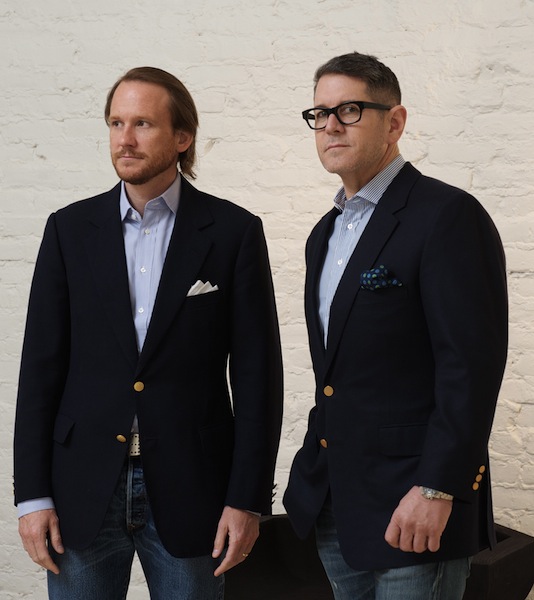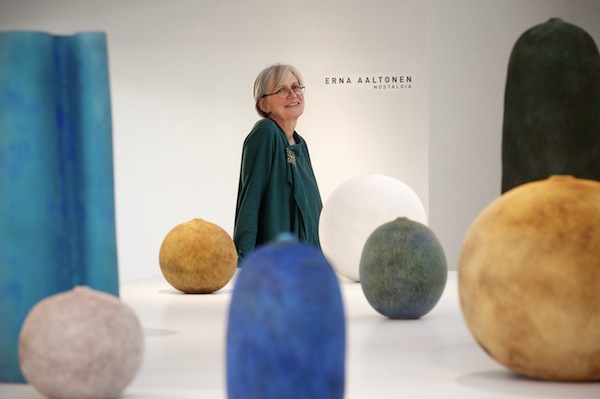"My eyes had been opened wide," Roth Martin says. He smiles. He has just described how his life had changed. "And it all began with some fireplace mantels."
What began was Hedge, a very-much-talked-about San Francisco gallery in which noted contemporary artists are shown on an exclusive basis, while at the same time tasteful, beautifully designed and unique work from the past, which Martin and Volpe have sought out on U.S. and international buying trips, is regularly shown.
"Our manifesto," Volpe says, "has always been to acquire and sell pieces that we would own ourselves. There are problems with that, because it's probably impossible to have an entire business based only on things that you would own on your own. But it gives us a focused set of criteria for what we will purchase and sell. We're increasingly trying to find things that are new and haven't been on the market before."

Roth Martin (l.) and Steven Volpe. Photo by Patrick Argast. Used courtesy of the photographer.
The two met when Volpe was doing the interior design for a house owned by Martin's father.
"I had never watched an interior designer work before," Martin says, "and I thought what Steven was doing was compelling. The beauty of it. The processes. All of it. My father and his wife Elizabeth were doing something very elaborate, a lot of eighteenth century ideas, " Martin laughs for a moment. "I actually thought it was all a little odd at first. Long discussions about curtains and sofas and things I had never thought you could talk about for that long." He folds his hands on the table before him. "And then I accompanied Elizabeth to Paris, with Steven, and, on his advice, I purchased a pair of fireplace mantels for a house I had just bought. From there, everything began to unfold in front of me. It was immediately interesting."
Martin and Volpe had come from very different beginnings.
"I worked for a Swiss commodities trading company for some years, in Connecticut," Martin says. "Then I was in an operations position in a bio-tech start-up here in the Bay Area that had been founded by two very bright guys from Cal Tech. So, really, I had no real training for something like Hedge. (Laughter.) Nor, now, do I believe that there is any real training."
Volpe came from the design industry. "I had worked with Tony Hail and Eleanor Ford, both prominent San Francisco interior decorators. I lived and worked for a few years in Paris, and when I came back to San Francisco, a friend of mine, Richard Tam, also an important San Francisco designer, gave me a very large project at The Brocklebank." A prestigious 1926 apartment building that neighbors The Mark Hopkins Hotel, the Brocklebank is steps away from the summit of Nob Hill. "Basically, with that, Richard had given me a career, and Steven Volpe Design was born."
Martin says that the career change for him was something of true emotional importance. "I had always had a real appreciation for good graphic design, something I inherited from my mother. The business acumen I had gotten from my father, and the combination of the two interests brought me to this business."
"When we go out to buy vintage things, from the '30s, '40s or '50s," Volpe says, "we look for integrity. Fine design. And what we are looking for in our contemporary artists are people who have a similar commitment to that kind of integrity."
Interestingly, when I commented on the great beauty of, and enthusiastic public response to, what Hedge shows, Martin made a remark about failure. "I'm interested in artists who have really sweated over making the piece. I actually like artists who have experienced a huge amount of technical failure. People who have suffered, doing what they do."
A vivid illustration of this idea can be found in the current show at Hedge (through June 12), the ceramic pieces of Finnish artist Erna Aaltonen. The title of the show -- her first in the United States -- is "Nostalgia."

Erna Aaltonen. Photo by Patrick Argast. Used courtesy of the photographer.
Aaltonen lives in Fiskars, a little village about eighty kilometers from Helsinki. Six hundred people reside there, about 120 of which are artists. "We have a cooperative of craftspeople, carpenters, some blacksmiths, ceramicists, clothing designers ... painters, sculptors, designers..."
When I ask her to describe her own work, Aaltonen grins. "That is a good question! I listen to the radio a lot while I work, and one day I heard a discussion about nostalgia, what it is and why people enjoy it so. To me, 'nostalgia' means longing for home, longing for something that was, that has been lost."
She looks aside, searching for more detail, for more of a way to express what she feels ... about what was. "Nowadays, so much that is designed is made in factories, while these pieces of mine are really hand-made ... entirely."
Martin leans forward. "It's like what we were talking about before ... literally!" He turns toward Aaltonen. "You know, those three or four large pieces that you did that were..."
"Lost!" Aaltonen interjects. She laughs, with a very ironic shrug. "These were large pieces that were intended for this show ... but they were broken during the process."
I had assumed that the process she was speaking of was that of clay thrown onto a wheel and worked and shaped in the time-honored fashion.
"No, I construct them by hand from flat strips of clay," Aaltonen says. "I make them into coils, and then I adhere them to each other along the edges. With my fingers! Then I glaze them, which itself is a complex process. And if I make a single mistake, and they are not fitted exactly perfectly ... well, once they get into the kiln, they break apart."
When you see Aaltonen's pieces that have made it through the firing process, the apparent simplicity of their design belies the remarkable complexity of their construction. But that simplicity and the gorgeous color take you directly into a contemplative moment in which the confusion and noise of contemporary life are diminished. Your soul wanders. You dream.
"Maybe it's that which we've really lost," Aaltonen says. "And maybe it's that which I wish to remember."
Hedge, 501 Pacific Avenue, San Francisco 94133. 415-433-2233
